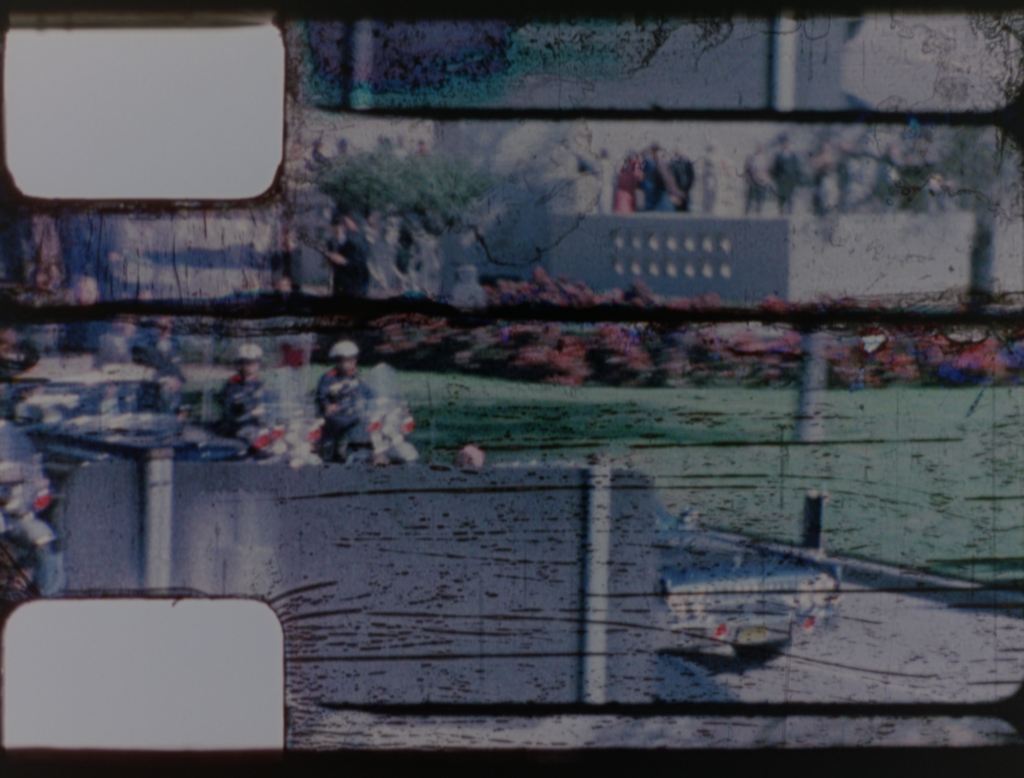
Frame 212 is one of the most visibly altered frames in the entire Zapruder film. A thick black stripe cuts through the top third of the image, obscuring what should be a continuous visual of the landscape.
What remains visible is both jarring and unnatural: the upper portion of a tree and part of its trunk appear at the top of the frame, while the base of the same trunk is disconnected, hovering several feet away. The tree appears severed—as if spliced back together incorrectly, a visual glitch in what should be a seamless 8mm strip of history.
This isn’t a natural degradation of film. This is human intervention. Time, Inc.—which had purchased the film the day after the assassination—later admitted that Frame 212 was physically damaged during handling by one of its own technicians, reportedly over the weekend following November 22, 1963. But even that admission was delayed for years and offered without detail. Who caused the damage? Why was this technician handling the film? Under what conditions? Those questions were never answered.
Frame 212 is the companion to Frame 207, which was also damaged, while Frames 208 through 211 were lost entirely. According to Time, the damage occurred during publication—but no technical report or chain of custody has ever been released. The explanation remains a vague shrug, even though this sequence of frames—just moments after the fatal headshot—could hold critical clues about the reactions of the motorcade, bystanders, or possible follow-up shots.
When it finally admitted the existence of the splice, Time asserted that its mistake was meaningless because Zapruder made three copies prior to selling the original to Time. However, this argument is incorrect on the facts and also appalling in trying to shirk responsibility. The existing copies are only partial copies that do not include the images between the sprocket holes. More important, the fact that there happen to be copies does nothing to excuse the destruction of the original. The original Zapruder film is a unique visual record—its color fidelity, film grain, and micro-details are irreplaceable. Damage to any frame—particularly during such a pivotal sequence—is not simply unfortunate. It is a breach of responsibility.
Life Magazine, owned by Time, Inc., was a powerful gatekeeper of public narrative, and in the days following the assassination, it took full control of the most important piece of visual evidence in American history. That a technician—on the job just hours after the event—was allowed to touch, manipulate, and ultimately damage the film without consequence remains deeply troubling.
What’s perhaps most remarkable is how readily this vague explanation has been accepted by the public—or more accurately, how little it has been questioned. For decades, the narrative that a Life Magazine technician accidentally damaged these frames has passed without serious challenge, despite the fact that no detailed account, internal memo, or technical explanation has ever been released.
It’s as if the mere acknowledgment of damage was treated as sufficient, without any meaningful follow-up or investigation. But given the magnitude of what was lost, it’s worth asking: why hasn’t this story been scrutinized more carefully? Perhaps it’s time for that to change. Time, Inc. (now part of a larger corporate structure), and the Sixth Floor Museum—who claims ownership of the Zapruder film today—may be private institutions, but they are custodians of public history. Their continued silence on the specifics of the damage to Frame 212, and the frames surrounding it, is no longer acceptable. The public deserves more than vague allusions to a “technician” and a “duplication accident.” These are not just frames of film—they are fragments of a national tragedy. And while the past cannot be undone, full transparency is the bare minimum owed to the American people.
Frame 212 is more than just a mangled piece of celluloid. It is emblematic of how lack of transparency deprived the American people of a clear view of a national trauma. And like the broken tree it depicts, it serves as a metaphor for something once whole, now irrevocably split.